Input interpretation

tetrahydrofuran
Chemical names and formulas
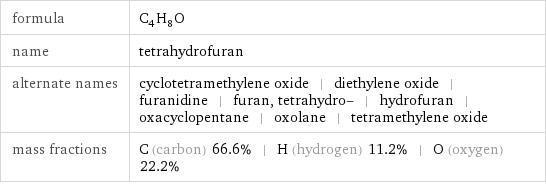
formula | C_4H_8O name | tetrahydrofuran alternate names | cyclotetramethylene oxide | diethylene oxide | furanidine | furan, tetrahydro- | hydrofuran | oxacyclopentane | oxolane | tetramethylene oxide mass fractions | C (carbon) 66.6% | H (hydrogen) 11.2% | O (oxygen) 22.2%
Lewis structure
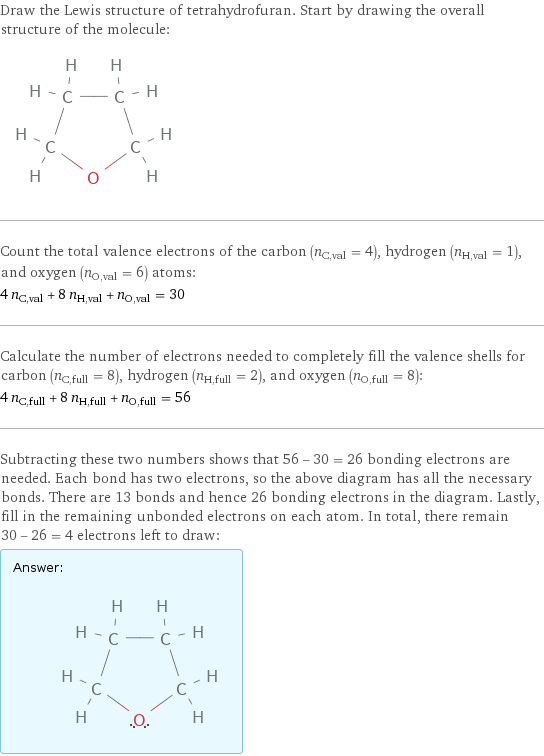
Draw the Lewis structure of tetrahydrofuran. Start by drawing the overall structure of the molecule: Count the total valence electrons of the carbon (n_C, val = 4), hydrogen (n_H, val = 1), and oxygen (n_O, val = 6) atoms: 4 n_C, val + 8 n_H, val + n_O, val = 30 Calculate the number of electrons needed to completely fill the valence shells for carbon (n_C, full = 8), hydrogen (n_H, full = 2), and oxygen (n_O, full = 8): 4 n_C, full + 8 n_H, full + n_O, full = 56 Subtracting these two numbers shows that 56 - 30 = 26 bonding electrons are needed. Each bond has two electrons, so the above diagram has all the necessary bonds. There are 13 bonds and hence 26 bonding electrons in the diagram. Lastly, fill in the remaining unbonded electrons on each atom. In total, there remain 30 - 26 = 4 electrons left to draw: Answer: | |
3D structure
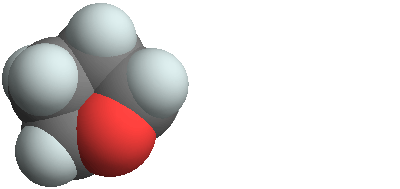
3D structure
Basic properties
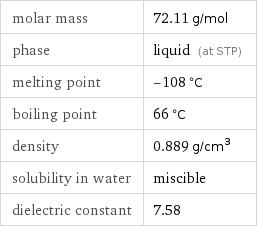
molar mass | 72.11 g/mol phase | liquid (at STP) melting point | -108 °C boiling point | 66 °C density | 0.889 g/cm^3 solubility in water | miscible dielectric constant | 7.58
Hydrophobicity and permeability properties

experimental LogP hydrophobicity | -2.7 predicted LogP hydrophobicity | -0.96 predicted LogS | -3.22
Basic drug properties

approval status | approved | nutraceutical | small molecule drug categories | dietary supplement | micronutrient
Liquid properties (at STP)
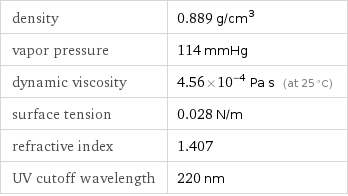
density | 0.889 g/cm^3 vapor pressure | 114 mmHg dynamic viscosity | 4.56×10^-4 Pa s (at 25 °C) surface tension | 0.028 N/m refractive index | 1.407 UV cutoff wavelength | 220 nm
Units
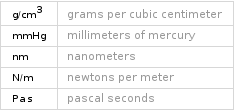
Thermodynamic properties
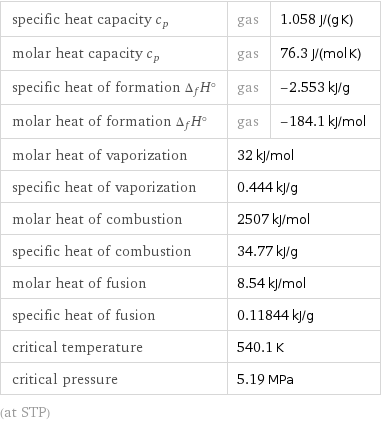
specific heat capacity c_p | gas | 1.058 J/(g K) molar heat capacity c_p | gas | 76.3 J/(mol K) specific heat of formation Δ_fH° | gas | -2.553 kJ/g molar heat of formation Δ_fH° | gas | -184.1 kJ/mol molar heat of vaporization | 32 kJ/mol | specific heat of vaporization | 0.444 kJ/g | molar heat of combustion | 2507 kJ/mol | specific heat of combustion | 34.77 kJ/g | molar heat of fusion | 8.54 kJ/mol | specific heat of fusion | 0.11844 kJ/g | critical temperature | 540.1 K | critical pressure | 5.19 MPa | (at STP)
Chemical identifiers
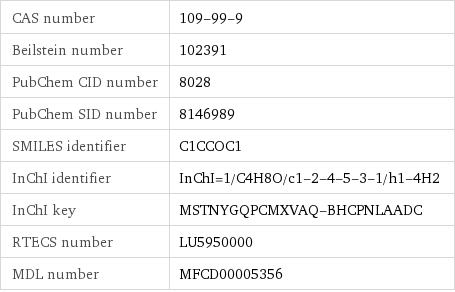
CAS number | 109-99-9 Beilstein number | 102391 PubChem CID number | 8028 PubChem SID number | 8146989 SMILES identifier | C1CCOC1 InChI identifier | InChI=1/C4H8O/c1-2-4-5-3-1/h1-4H2 InChI key | MSTNYGQPCMXVAQ-BHCPNLAADC RTECS number | LU5950000 MDL number | MFCD00005356
NFPA label

NFPA label
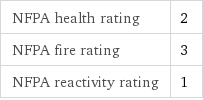
NFPA health rating | 2 NFPA fire rating | 3 NFPA reactivity rating | 1
Safety properties
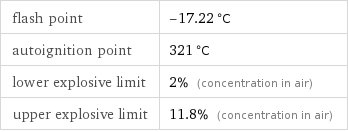
flash point | -17.22 °C autoignition point | 321 °C lower explosive limit | 2% (concentration in air) upper explosive limit | 11.8% (concentration in air)

DOT hazard class | 3 DOT numbers | 2056
Toxicity properties
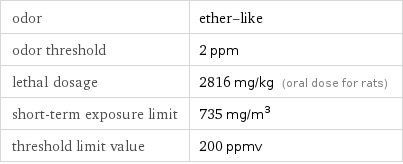
odor | ether-like odor threshold | 2 ppm lethal dosage | 2816 mg/kg (oral dose for rats) short-term exposure limit | 735 mg/m^3 threshold limit value | 200 ppmv

probable lethal dose for man | 600 mL (milliliters) long-term exposure limit | 590 mg/m^3 (over 8 hours) RTECS classes | tumorigen | mutagen | reproductive effector | human data